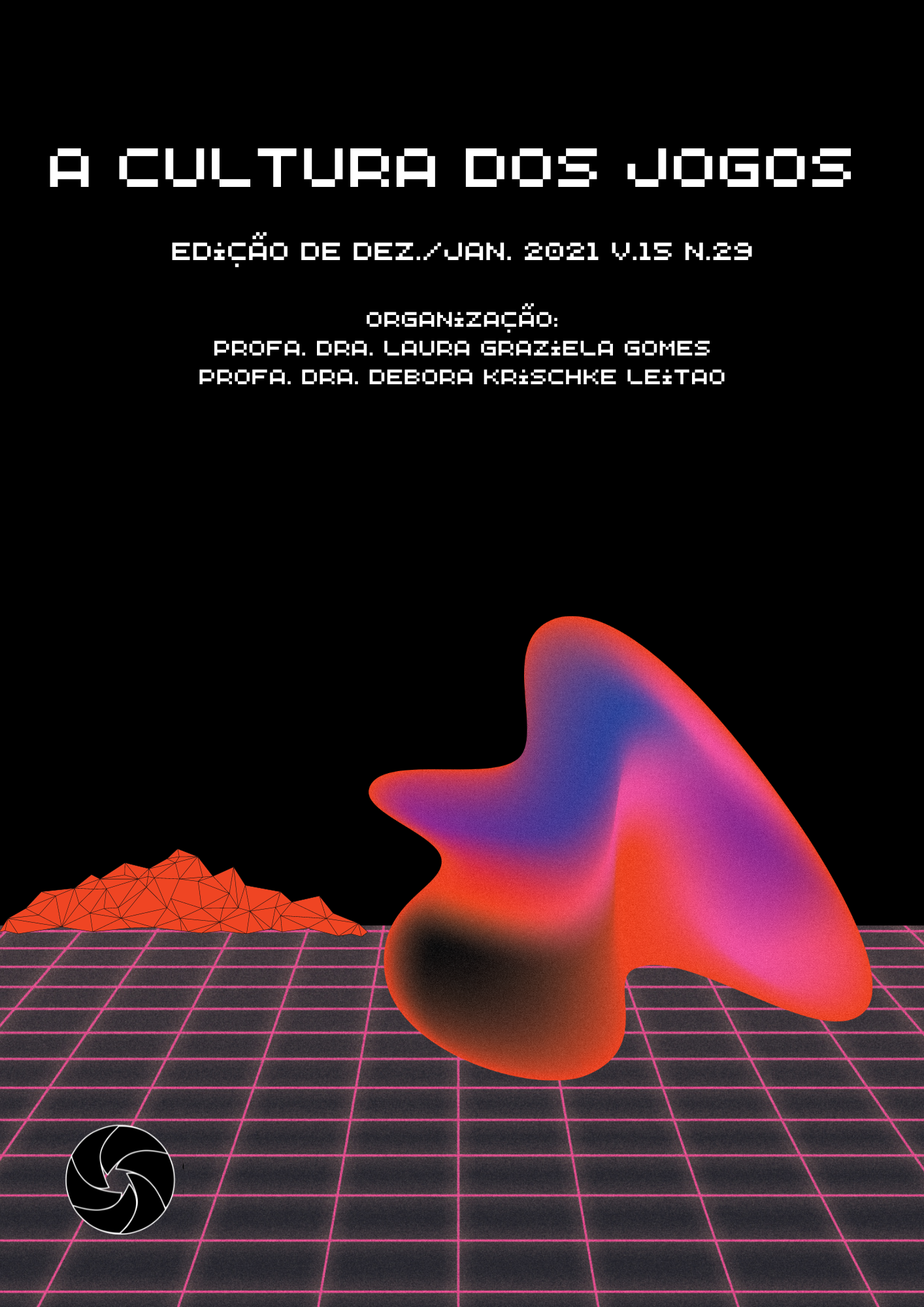Death By Cuteness - Ética Queer-Afetiva e a Estética da Fofura
DOI:
https://doi.org/10.5433/2237-9126.2021v16n29p80Palabras clave:
Jogos Digitais, Jogos Queer, Sexualidade, GêneroResumen
Este artigo trata da observação de um Workshop da cena queer avant garde de jogos digitais da Baía de San Francisco, uma cena de produção acadêmica e de jogos queer norte-americana. As cenas queer de jogos digitais são reconhecidas por apropriarem-se de dinâmicas constitutivas dos jogos digitais (como narrativa e mecânicas inerentes aos jogos digitais), assim como de outras estéticas da cultura pop e de elementos históricos das identidades e movimentos LGBTQ. Estas manifestações visam, ao mesmo tempo, produzir novas maneiras de narrar experiências não-heterossexuais e não-cissexuais, e resistir a compreensões hegemônicas que os excluem dessas culturas. Dessa maneira, aqui nos centramos nas relações estéticas organizadas por essa cena, em especial à estética da fofura (”cute”), e de que maneira essa é compreendida e utilizada tanto para um acesso simbólico e afetivo diferencial para essas comunidades quanto como resistência à temas estéticos e mecânicos do jogo digital mainstream.
Descargas
Citas
CONDIS, Megan. No homosexuals in Star Wars? BioWare,‘gamer’identity, and the politics of privilege in a convergence culture. Convergence, v. 21, n. 2, p. 198-212, 2015.
DECATUR, Mary-Anne. Consuming Cuteness in Japan: Hello Kitty, Individualism and Identity. Popular Anthropology Magazine, v. 3, n. 1, 2012b.
DONOVAN, Tristan. Replay: The history of video games. Yellow Ant, 2010.
FANTONE, Laura. Video Games and Queerness in California. Digital Creativity, v. 25, n. 4, 2014, p. 357-359.
FRON, Janine; FULLERTOM, Tracy; MORIE, Jacquelyin Ford; PEARCE, Celia. The hegemony of play.In: Situated Play: Proceedings of Digital Games Research Association 2007 Conference. Tokyo, Japan. 2007, p.1-10.
GOETZ, Christopher. Coin of another realm: Gaming’s queer economy. Game Studies, v. 18, n. 3, 2018.
GOETZ, Christopher. Building Queer Community. First Person Scholar, 2015. Disponível em: http://www.firstpersonscholar.com/building-queer-community/. Acesso em: jun/ 2017.
GOULART, Lucas Aguiar; NARDI, Henrique Caetano. O Circuito da Diversão ou Da Ludologia à Ideologia: Diversão, Escapismo e Exclusão na Cultura de Jogo Digital. Logos, v. 26, n. 2, 2019, p. 72-85.
HARRIS, Daniel. Cute, Quaint, Hungry, and Romantic: The Aesthetics of Consumerism. New York: Basic Books, 2000.
KINSELLA, Sharon. Cuties in japan. Women, media and consumption in Japan, 1995, p. 220-254.
KLINE, Stephen; DYER-WITHEFORD, Nick; DE PEUTER, Greig. Digital play: The interaction of technology, culture, and marketing. Montreal, McGill-Queen's Press-MQUP, 2003.
MUÑOZ, José Esteban. Disidentifications: Queers of color and the performance of politics. Unniversity of Minnesota Press, 1999.
MUÑOZ, José Estevan. Ephemera as evidence: Introductory notes to queer acts. Women & Performance: a journal of feminist theory, v. 8, n.2, 1996, p. 5 -16.
NGAI, Sianne. Our aesthetic categories: Zany, cute, interesting. Harvard Press 2012.
NGAI, Sianne. Ugly feelings. Harvard University Press, 2005.
POZO, Diana; RUBERG, Bonnie; GOETZ, Chris. Practice Queerness and Games. In: Camera Obscura: Feminism, Culture, and Media Studies, v. 32, n. 2 (95), 2017, p. 153-163.
POZO, Teddy. Queer games after empathy: Feminism and haptic game design aesthetics from consent to cuteness to the radically soft. Game Studies, v. 18, n. 3, 2018.
RUBERG, Bonnie. Queering indie. In: RUFFINO, Paolo. Independent Videogames: Cultures, Networks, Techniques And Politics, Routledge, 2020a.
RUBERG, Bonnie. The queer games avant-garde: How LGBTQ game makers are reimagining the medium of video games. Duke University Press, 2020b.
RUBERG, Bonnie. The Queerness and Games Conference. In: PAYNE, Matthew Thomas; HUNTEMANN, Nina. How to Play Video Games. NYU Press, 2019.
SEDGWICK, Eve Kosofsky. Touching feeling: Affect, pedagogy, performativity. Duke University Press, 2003.
SHAW, Adrienne. Do you identify as a gamer? Gender, race, sexuality, and gamer identity. New media & Society, v. 14, n. 1, 2012, p. 28-44.
SHAW, Adrienne. Gaming at The Edge: Sexuality and Gender at the Margins of Videogame Culture. Minneapolis: University of Minnesota Press, 2014.
SHAW, Adrienne. What is video game culture? Cultural studies and game studies. Games and culture, v. 5, n. 4, 2010, p. 403-424.
SHAW, Adrienne. Rethinking game studies: A case study approach to video game play and identification. Critical studies in media communication, v. 30, n. 5, p. 347-361, 2013.
SICART, Miguel. Values between systems: Designing ethical gameplay. In: Ethics and Game Design: Teaching Values through Play. New York, Information Science Reference, 2010, p. 1-15.
STOCKTON, Kathryn Bond. The queer child, or growing sideways in the twentieth century. Duke University Press, 2009.
Imagens:
ANTHROPY, Anna. Gay Cats Go To The Weird Weird Woods; 2015
EPIC GAMES. Gears of War 3. 2011
EMPTY FORTRESS. A Russian Valentine. 2013
KOPAS, Merritt. Hugpunx, 2013
NAMCO. Pac Man, 1980
NOON, CEREY E VULVASAUR, 2014. Ultimate Star Collector: Winner of the Universe, 2014
Descargas
Publicado
Cómo citar
Número
Sección
Licencia
Domínios da Imagen adopta la Licencia Internacional Creative Commons Atribución 4.0, por lo tanto, los derechos de autor relativos a los artículos publicados pertenecen al autor(es), quienes otorgan a la revista el derecho exclusivo de primera publicación.
Bajo esta licencia usted puede: Compartir - copiar y redistribuir el material en cualquier medio o formato. Adaptar: remezclar, transformar y desarrollar sobre el material, otorgando el crédito correspondiente, proporcionando un enlace a la licencia e indicando si se realizaron cambios.












 Las obras de esta publicación tienen licencia Creative Commons.
Las obras de esta publicación tienen licencia Creative Commons.